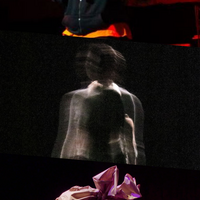Tue 24 May: Bodies in Action – enGendering Contemporary Dance/Laura Calcagno/ Tough Boys Dance Collective

News Story
Bodies in Action – enGendering Contemporary Dance IMPOSTER
Laura Calcagno Winter Tears
Tough Boys Dance Collective DJ as Witness
Let’s face it, clowns are just creepy. Opening IMPOSTER, choreographer Julian Nichols looks deadpan in white facepaint, eyes, eyebrows and lips daubed black, half smiling, half grimacing. He’s a deft mover, a battery-powered presence who steps, slides and rebounds as if through a mutating maze of corridors that keeps blocking his path. As he leaves, two women with painted grins (Jordan Boyle and Kate Thomas, one in white, one in black, assured movers too) continue the complicated game of blocks and feints, now with each other rather than with the space. More a study of movement and mood than a finished work, IMPOSTER nevertheless holds attention and fascination.
There’s no masking in Laura Calcagno’s Winter Tears: this is the direct, uncovered expression of a heartbreak – or at least, a breakup. Calcagno unpacks herself from inside a wooden box, shadows of both body and box looming large and black behind her. Outside the box, she is still not free of it, her body stretching to breaking point as its gravitational pull tugs her into unstable overreaches and anguished twists. After a slow retreat – a tolling chord, rather than her body, now fills the emotional space – she turns more ironic, a voiceover narrating the primal cheating scene. Calcagno’s worked-through material and committed performance stop the piece from sliding into self-indulgence.
Sanjoy Roy
In IMPOSTER, three dancers explore the internal struggle of one. Julian Nichols begins fluidly, but is interrupted by rebounds and sharp stops, his own body surprising him as he’s plagued by The Dale Cooper Quartet's distorted guitar. The tension is broken by the comic entrance of two dancers inspired by their accompaniment, Be a Clown. Their duet forms the rest of the work. Struggling between needing each other and not, we’re never sure when one meets the other if it’s to support or manipulate them. While the mixture of contact and solo work is well-constructed, it lacked direction in the end. Perhaps this is the exact point of the piece. All three dancers sport painted faces, one with a permanent black smile, poking fun at the belief that we can succeed on our own.
Laura Calcagno shares her heartbreak in Winter Tears. The most straightforward piece of the night, it offers an engaging and accessible narrative without being patronising. We witness her pain and desperation as she throws herself in and out of the floor with increasing intensity. She repeats moments until breathlessness, striving for something unattainable. Though her character eventually gives up with her situation, her struggles are balanced by an episode of ironic confidence as she confronts her partner through a voiceover, letting the audience in on her side with raised eyebrows and side glances. While not the most thought-provoking, Winter Tears is surely entertaining.
From catwalks and silhouettes to muscle men and DJ worship, DJ as Witness is certainly a “simmering collection.” Daze Hingorani is curled up on stage as the audience enters, visible only by the spillover from the house lights and the projections of words comparing the DJ to the Messiah. This is their space. In between bouncing, stomping and grooving to thumping bass, Tough Boys Dance Collective finds quieter moments. After showing off their figure, one dancer describes the pressure of a hand on their lower back, while another moment finds intimacy in touching foreheads. The hodgepodge of events is often confusing, but enjoyably so and much like the queer experience.
Luke Hodkinson


